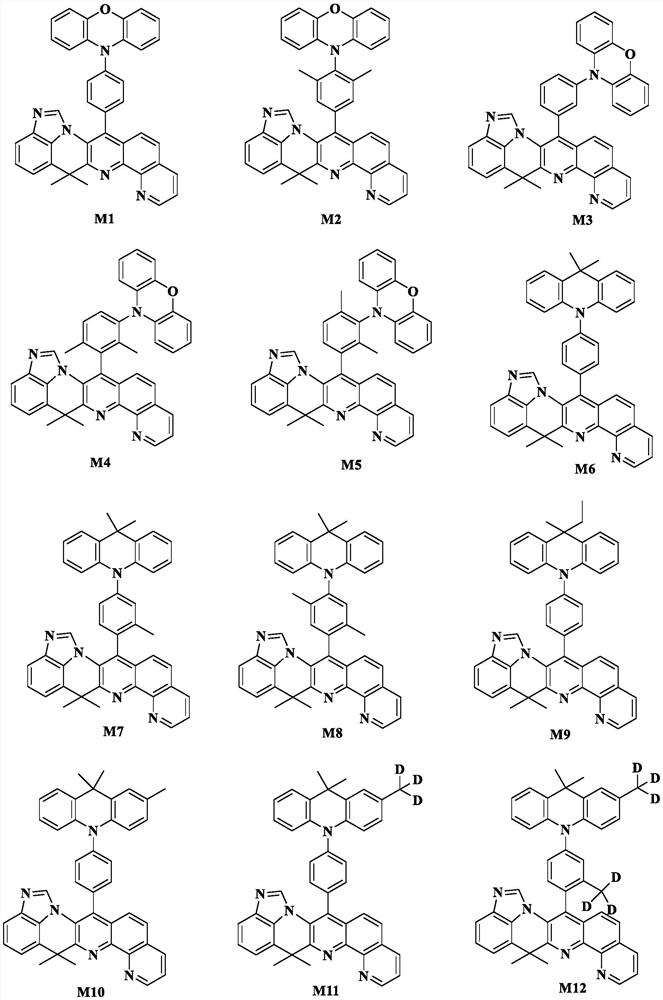Organic compound, organic light-emitting display panel and application thereof
An organic compound, unsubstituted technology, applied in the field of organic electroluminescent materials, can solve the problems of long lifetime, reduced lifetime, and easy breakage of triplet excitons, and achieve a short transient fluorescence lifetime, long lifetime, and strong rigid structure. Effect
- Summary
- Abstract
- Description
- Claims
- Application Information
AI Technical Summary
Problems solved by technology
Method used
Image
Examples
Embodiment 1
[0082] The present embodiment provides an organic compound M3 whose structural formula is as follows:
[0083]
[0084] The preparation method of this organic compound M3 comprises the following steps:
[0085] (1) Preparation of compound c-1
[0086]
[0087] Compound a-1 (11.8 g, 0.1 mol) and compound b-1 (34.9 g, 0.1 mol) were dissolved in 500 mL of toluene solution, potassium carbonate (13.8 g, 0.1 mol), 1 g of tetrakistriphenylphosphine palladium and 50mL of tetrakistriphenylphosphine solution, replaced with nitrogen, then heated to 100°C, stirred for 8h, after the reaction was completed, cooled to room temperature, poured into water, filtered, and recrystallized to obtain compound c-1 (38g, 0.0884mol), yield rate 88.4%;
[0088] MS[M+H] + calcd for C 28 H 23 N 4 O: 431.5, found: .MS=431.5.
[0089] (2) Preparation of compound d-1
[0090]
[0091] Compound c-1 (21.5 g, 50 mmol) was dissolved in 200 mL of concentrated H 3 PO 4 The solution was stirred a...
Embodiment 2
[0102] This embodiment provides an organic compound M4, the structural formula is as follows:
[0103]
[0104] The preparation method of this organic compound M4 comprises the following steps:
[0105] (1) Preparation of compound c-3
[0106]
[0107] Compound a-1 (11.8 g, 0.1 mol) and compound b-3 (37.7 g, 0.1 mol) were dissolved in 500 mL of toluene solution, potassium carbonate (13.8 g, 0.1 mol), 1 g of tetrakistriphenylphosphine palladium and 50mL of tetrakistriphenylphosphine solution was replaced with nitrogen, then the temperature was raised to 100°C, stirred for 8h, after the reaction was completed, it was lowered to room temperature, poured into water, filtered, and recrystallized to obtain compound c-3 (32.4g, 0.075mol), Yield 70.5%;
[0108] MS[M+H] + calcd for C 30 H 27 N 4 O: 459.6, found: .MS=459.6.
[0109] (2) Preparation of compound d-3
[0110]
[0111] Compound c-3 (22.9 g, 50 mmol) was dissolved in 200 mL of concentrated H 3 PO 4 The solut...
Embodiment 3
[0122] The present embodiment provides an organic compound M5, the structural formula is as follows:
[0123]
[0124] The preparation method of this organic compound M5 comprises the following steps:
[0125] (1) Preparation of compound c-4
[0126]
[0127] Compound a-1 (11.8 g, 0.1 mol) and compound b-4 (37.7 g, 0.1 mol) were dissolved in 500 mL of toluene solution, potassium carbonate (13.8 g, 0.1 mol), 1 g of tetrakistriphenylphosphine palladium and 50mL of tetrakistriphenylphosphine solution was replaced with nitrogen, then heated to 100°C, stirred for 8h, after the reaction was completed, it was lowered to room temperature, poured into water, filtered, and recrystallized to obtain compound c-4 (22.9g, 0.05mol), Yield 50%;
[0128] MS[M+H] + calcd for C 30 H 27 N 4 O: 459.6, found: .MS=459.6.
[0129] (2) Preparation of compound d-4
[0130]
[0131] Compound c-4 (22.9 g, 50 mmol) was dissolved in 200 mL of concentrated H 3 PO 4 The solution was stirre...
PUM
 Login to View More
Login to View More Abstract
Description
Claims
Application Information
 Login to View More
Login to View More - R&D
- Intellectual Property
- Life Sciences
- Materials
- Tech Scout
- Unparalleled Data Quality
- Higher Quality Content
- 60% Fewer Hallucinations
Browse by: Latest US Patents, China's latest patents, Technical Efficacy Thesaurus, Application Domain, Technology Topic, Popular Technical Reports.
© 2025 PatSnap. All rights reserved.Legal|Privacy policy|Modern Slavery Act Transparency Statement|Sitemap|About US| Contact US: help@patsnap.com



